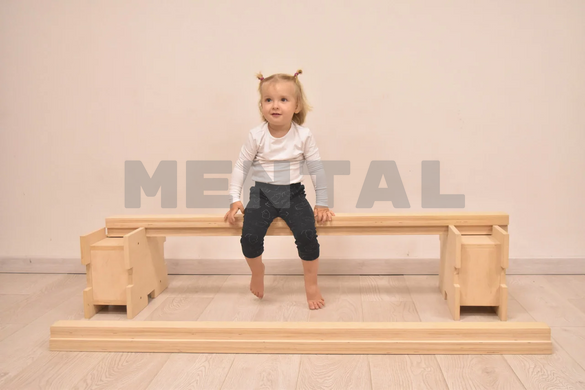|
Quantity
|
Out of stock
|
||
|
|
|||
A balancing bar is used in cases of vestibular system disorders.
You can perform exercises with amygdala stimulation first on a balance board, and the next step is to use a balance board) Especially with children who find it difficult to keep their balance on a balance board.
The purpose of balance beam exercises is to improve balance while walking.
First of all, we are interested in the development of reciprocal connections and integration between the two hemispheres of the brain and between the two sides of the body that they control, and not in teaching a child to walk on a balance beam without falling. As we increase the demands on maintaining balance while performing the exercises, we increase the demands on the system of integration of the two separate sides. The higher the level of balance, the higher the level of integration required for adequate performance.
When a child learns to balance while walking on a balance board, it does not always provide a significant training effect, because there are two ways to perform the task. It can perform a task quite effectively by integrating two systems into one, or it can perform a task with tension by suppressing those parts of the systems that it cannot integrate or harmonize. If the child performs the exercise according to the last of the described samples, the therapy will not be effective. If a child uses a suppression model to complete a task, his trunk and limbs will be tense and stiff, and the movement he uses to maintain balance will be jerky. Because his body is tense, the child will expend an excessive amount of energy on the task, working against himself. To move, he would have to overcome the tension in his tight muscles. The suppression pattern can be changed by modifying the exercises. All training consists of relationships. In this regard, learning motor skills is no different from higher abstract thinking, which is provided by a certain model of relations. A certain scheme of connected movements provides the most effective ways of performing a motor task. In an abstract sense, we start with a concept and relate this concept to other concepts; the more broadly we consider it, the greater will be the coverage of the new concept and the more significant the solution to the problems. Motor development occurs according to the same scheme. We start with movement exercises and make small changes to them. When the child performs the first task and changes the movement pattern according to the changes in the task, he develops the first movement model. The more we develop, the more flexible the system will be because it will have many possibilities to respond. The main rule for perceptual-motor development is to use the largest number of related exercises. The system will choose the most effective possible response to solve the problem. There are many models for a child to perform a task, such as walking on a balance beam. Some are completely ineffective and require excessive energy consumption. Other models are more effective. The effectiveness of the motion model is determined by the relationship of the motion model to the laws of motion. The more in harmony with the laws of motion the motion model is composed, the higher the effectiveness of this model.
By using the variations of the balancing block exercise when performed by the child for the first time, we help him to expand the reaction pattern and reduce the suppression pattern. There will always be a certain amount of suppression, and by building a broad generalized system, we will greatly reduce this tendency.
Sometimes we think that perceptual-motor development is a simple low-level activity, something that does not require high intellectual activity. Observing how a child walks on a balance beam and at the same time throws and catches polystyrene bags, looking at the processes associated with the performance of this task, in the end, we will understand that this is not such a low-level action. When a child walks on a balancing block, he must change the basic walking pattern in such a way that the movement pattern for grasping the bag can be combined with the basic walking pattern without disturbing the overall balance of the system. When a child walks and throws a polystyrene bag at a moving target, the basic walking pattern, the throwing pattern and the movement pattern of the moving target must be integrated. At the same time, the child must project his own movement; the movement of a bag in flight and the movement of a moving target. He must project where the moving target will be with the hour and throw the bag in such a way that it reaches the same point at the same hour. This is quite an achievement.
We are interested in the maximum possible integration of vision when performing exercises. Balance exercises help us build relationships between the two sides of the body and the two hemispheres of the brain that control each side. These exercises also help us establish a more subtle connection between visual and kinesthetic or motor modalities. If you stand on one leg and keep your balance, and then close your eyes and try to keep it, you will see the connection between vision and balance. If you stand on a log and close your eyes (bu
child be careful), you can see the meaning of vision in this position. Naturally, if you make balance exercises more difficult, you increase the demands on vision, which in turn provides a closer connection or a higher level of integration between the visual and kinesthetic or motor systems.
The following sequences can be varied by performing them at different deck balancing levels:
Sequence #1.
1. Stand at one end of the balancing block. Follow the balancing log without taking your eyes off the fixation point. Try to relax and maintain balance with the help of the whole body.
2. Follow the balancing log back, without taking your eyes off the fixation point. Try to relax and feel balanced.
3. Reach over and grab one of the styrofoam bags. Look at the fixation point. Take the bag in your left hand. Keep your left arm extended at shoulder level and go to the fixation point. Be sure to follow the fixation point while walking and feel the balance.
4. Transfer the bag to the other hand and follow the balancing log. Keep an eye on the fixation point.
5. Put a polystyrene bag on the top of the head. Follow the balancing log, looking at the fixation point and trying to see as much as possible around it.
6. Keeping the bag on your head, walk back to the balancing log.
7. Extend both arms to the sides, hold at shoulder level with palms up. Go for the balancing log.
8. With both hands, remove the bag from the crown of the head.
9. Keep your hands behind your back and follow the balancing log.
10. Walk back to the balancing log, keeping your hands behind your back and trying to balance with your hips.
11. When you reach the end of the balancing block, take the styrofoam bag and throw it away. Try to make the bag fall on the opposite end of the balancing block.
12. Hold your hands in front of you, palms down. Go for the balancing log.
13. Close your hands in front of you and walk back to the balancing log.
14. Follow the balancing log sideways.
15. Turn around and follow the balancing log to the other side.
16. Try turning around your axis while walking on the balance board.
17. Clap your hands while walking on a balance beam. Try to keep a slow steady rhythm
18. Go for the togo balancing deck. Clap your hands and keep the rhythm. Use a metronome.
19. Go to the center of the balancing log, bend down and touch the knee, straighten up and go to the end.
20. Slaps on the sides while walking on the balance board. Try to keep the rhythm while clapping. Do one step for each cotton.
21. Walk sideways on the balancing log.
22. Walk sideways on your socks on the balance board.
23. Go to the deck balancing center and get the weights. Swing the weights back and forth, taking one step with each swing.
24. Keep your hands to your sides. Make circular movements. Try to make your arms and legs work together. Keep an eye on the anchor point when walking on the balance board.
25. Walk sideways on the balancing log. Make circular movements with your hands.
26. Walk behind the balance board, holding weights in each hand. Make waves with one hand back and forth, keep the other hand still.
27. Go behind the balancing platform and swing with one hand. Feel how you have to shift your body to keep your balance.
28. Follow the balancing log ahead. Follow the fixation point and swing with the other hand.
One of the problems or disadvantages of using a programmed sequence in perceptual-motor therapy is that children may learn the sequence and perform the required exercises as a separate exercise rather than as part of a broad generalized pattern. This will not happen if we understand the process of generalization and apply it together with the programmed approach. A basic set of exercises can be used over and over again, changing it to develop the basic movement pattern needed to complete all the tasks in the sequence. For example, a child performs a sequence of exercises on a balance board. If the same sequence is used a second time with a weight (bracelets) on the same arm, the overall movement pattern required to perform the second sequence will be very different from the first, even though it is performing the same sequence of exercises. To complete the task a second time, he must integrate the changes caused by the dynamic inertial and gravitational properties of the weighting bracelet into the overall model, otherwise he will not be able to maintain balance and complete the task. There are other means that can be used to change the main cycle: working on different levels of balancing the blocks, changing the position of the fixation point.
With this tactic, we can program exercises and use the same program over and over again without developing a habit. The teaching of motor skills follows the model of general education, in which outand develop from the point of view of relations. By developing a basic cycle, we have a better chance of developing a system of relative movements. It's actually better to stop than to just do random exercises because we develop core exercises and establish relationships across a wide spectrum.









